
A gas generator is a great preparedness upgrade, but they have their limitations (i.e. fuel). A small-scale solar setup can help counter that limitation. This post explores how you can level up your preps.
A gas generator helps keep life fairly normal during short-term outages — the lights are on, the fridge stays cold, the furnace still heats, etc. Fueling your generator through the average outage does not take a prohibitive amount of fuel. The average family can ride out a grid-less day, or two, or three, in relative comfort.

For folks who tend to look beyond the short term, the question is: what do they do when their fuel runs out? Even hard-plumbed natural gas can fail due to gas line breaks or shutoffs due to fires, etc. If the outage turns out to be a week or more, do they have enough fuel stockpiled for a week? Two weeks? Acquiring more fuel after a longer-term outage has begun will probably be tough, if possible at all. Hundreds of other short-termers will all be looking for more fuel too.
The Next Level
The next level up from a generator is adding some small-scale solar capability. I say, “small-scale” for budgetary reasons. It is a Plan B for your Plan B (the generator). It need not be a solar duplicate to your whole-house generator, just like a donut spare tire is not an equal replacement for a regular tire. Instead, small-scale solar offers you a more affordable backup tool, if an outage were to last longer than your fuel. A couple of solar panels and a battery bank can supply you with some electric power long after the last drop of your gasoline runs out.
Small-Scale for Affordability
For a Plan C level of prep — essentially a backup to a backup — I am assuming a project in the range of a few hundred dollars, not thousands of dollars. If you can afford thousands, then sure, go for it. For those less flush with cash, a modest solar setup is more attainable. A small solar kit won’t impress OneUpsMen, but it can still give you some of the advantages of long-term electricity without devouring your kids’ college fund.
Buy or Build?
There are many pre-packaged solar kits out there with everything you’d need. While they are handy for one-click purchasing, I’ve found that they tend to charge you for that convenience. They are pricier than they need to be. Here are a couple of examples.
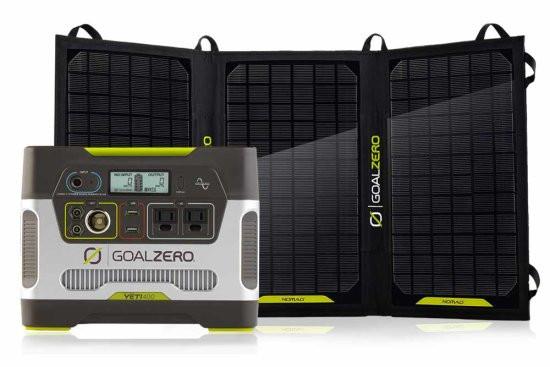
Goal Zero Yeti 400, with a 100-watt solar panel, sells for $849. Its lithium battery offers 428 wattHours. Cost: $1.98 per wattHour.
.
As a reminder, a wattHour is a measure of energy consumed over time. A 10-watt bulb left running for one hour uses 10 wattHours. Run that same bulb for ten hours and it used 100 wattHours, etc. What you’ll want to know, about any solar/battery system, is some statistic with “hours” in it. Volts alone don’t tell you enough. Watts alone don’t tell you enough.
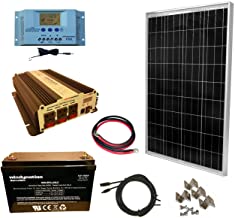
The WindyNation 100-watt kit offers 600 wattHours via its 100ah battery. It costs $579 — $1.04 per wattHour. This kit lacks the all-in-one box. Could you provide your own box for less than the $230 difference between the Yeti and the WindyNation kits? Probably.
Caveat Emptor
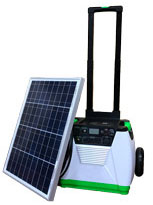
Shop around and compare prices per wattHour, etc. Don’t let sales hype cloud the math. I got an email promotion last week that spewed buckets of text about how their solar kit would free my family from slavery to the evil energy companies and power my modern life, etc., etc. The promo email trumpeted about how their unit could provide 1800 watts of power! Woohoo, right?
I had to really dig to discover that the kit had one 25aH battery and a single 100-watt solar panel. This rig could provide 1800 watts for 10 minutes. Does that sound like energy freedom to you? Don’t let the sales hype and sweeping promises snooker you into a lame deal.
Some kits are a much better deal for the seller than for you. The all-in-one packages are handy. There’s no denying that. If you’ve got the money and don’t want to fuss with DIY, operators are standing by. (do TV ads say that anymore, or did I just date myself?)
Build Your Own — Pay As You Go
If you are more of a DIY sort of person, you can buy the components separately and save a fair amount. One advantage to building your own, is that you can buy the components as you go. For a lot of folks, it is easier to scrape up $100 now and then, than to part with $800 all at once.

Despite the appearance of math, a basic solar setup is not rocket science. Aside from wiring and sundry things, what you’ll need is:
1. Solar panel(s)
2. A 12-volt battery (a lead-acid, deep cycle is best)
3. A charge controller
4. An inverter to convert DC (battery power) to AC power
Number 4 isn’t strictly necessary if you have only 12-volt items you plan to power. You will need an inverter if you plan to run some AC items. Strictly speaking, even the charge controller isn’t totally necessary. It just makes your life a lot easier. Let the controller regulate voltages and current.
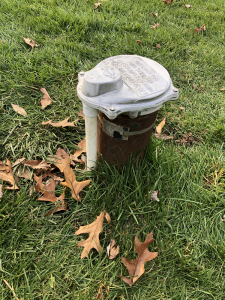
Where to start? — This is a similar kind of math class exercise as in my last post about sizing your generator. It helps to figure out beforehand what you absolutely, must power with your Plan C electricity. The biggest item on your list will be the tail that wags the dog.
I ran through my choices in my battery bank post, so let’s take my neighbor as another example. Let’s say that his critical prep is to be able to run his 220-volt, 8-amp well pump — even after his generator fuel runs out. How much solar does he need?
220 volts x 8 amps = 1760 watts. If he ran it for a full hour, that would be 1760 wattHours. He thinks that if he ran his well pump for a half-hour, he could store up 50 gallons — an ample supply for his family. Half of 1760 wattHours is 880 wattHours to run his pump for half an hour. Let’s round up to 900 for simpler math.
Sizing the battery to the task

900 wattHours divided by 12 volts equals 75 amp-hours. Since we don’t want to drain our batteries more than half their rated power before recharging, that means my neighbor would need 150 amp-hours worth of lead-acid battery. (75 is half of 150) Now, we have a number we can go shopping with. Let’s say he gets two matching 75 amp-hour, deep cycle batteries. Boom. One piece of the kit is figured out. This is the tail that wags our dog.
Sizing the solar panels
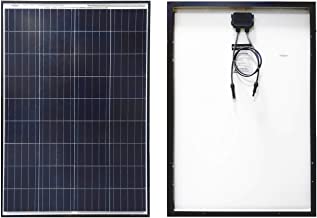
Knowing that he wants to use up 900 wattHours a day, he will want to buy enough solar panels to replenish that amount in a single sunny day. After all, he is planning to run his pump each day. Under ideal conditions, 100-watts of solar panel would take 9 hours to create 900 wattHours. 200-watts of solar panel would take 4.5 hours, etc. How much sun should he plan on?
Plan on partly sunny
The reality of solar power is that your panels will generate their rated watts (usually a bit less) for only a few hours in the middle of the day. See the chart below. On a clear and sunny day, you might get four good hours with a couple of mediocre hours before and after the peak. The rest of the daylight hours are not creating enough voltage to help your batteries. A panel creating 11 volts IS making electricity but not enough to increase the charge of a battery at 12 volts. Optimal hours aside, there are sometimes entirely non-optimal days. Clouds happen.
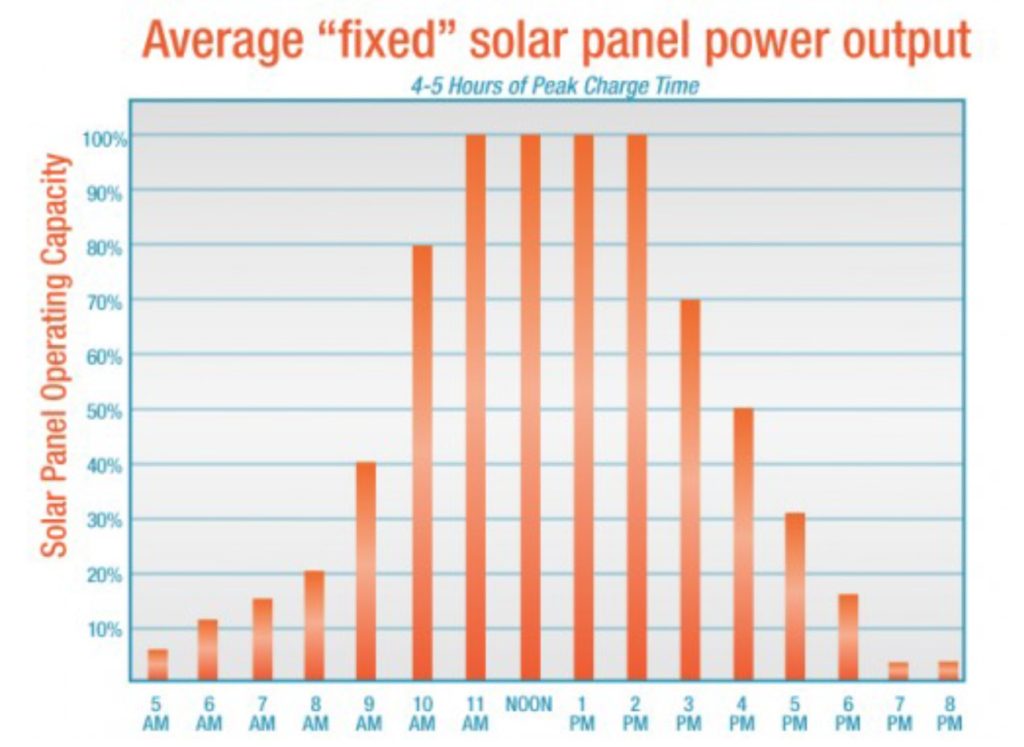
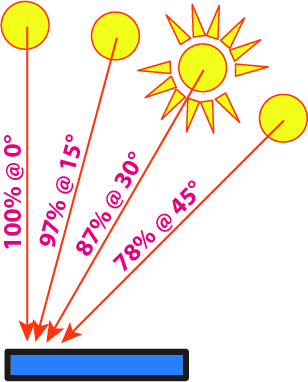
Fixed or Movable? Panels set in a fixed position are a lot less work. (mount ‘em and forget ‘em). But you never escape compromises. Fixed panels more prone to less-than-peak performance hours. Panels aimed at where the noonday sun will be, are at an angle to the 10:00 sun or the 2:00 sun. Output drops as the sun gets “off-angle” to the panel. There’s more math to figure that, but who wants to do more math? Just recognize that your panel rated at 100 watts might only be generating 50 watts while the sun is off-angle.
Motorized tracking equipment for solar panels can help, but is not cheap — and probably not justified for a small-scale setup. My Harbor Freight panels are portable with their own little kickstands, so I can (and do) re-orient them periodically as the sun moves around toward the West.
Let’s say that my neighbor assumes he will only get (effectively) 2 or 3 hours of good battery-charging sun each day. That means, to generate 900 wattHours, he would need 300 watts of solar panel power for a 3-hour recharge or 450 watts for a two-hour recharge. We’ll say he opts of 300 watts of panel to save money. The second piece of the puzzle is pegged.
Does the type of panel matter? Not so much
Once you start shopping for solar panels, you’ll find three different kinds: monocrystalline, polycrystalline, or “amorphous” or “thin film.” There are subtle performance differences but the bottom line is that a 100-watt panel makes 100 watts regardless of type, what varies is size and cost. The performance differences are beyond the scope of this post, but briefly:
Monocrystalline is the most efficient, so their panels tend to be smaller in size but more expensive. Polycrystalline is next in efficiency, size, and cost. Amorphous is less efficient, so they tend to be the biggest but also the least expensive. A small 100-watt monocrystalline panel and a larger 100-watt amorphous panel are both making 100 watts. Batteries don’t care about square feet. All they care about are watts.
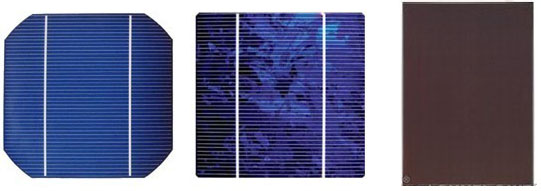
Sizing the charge controller

300 watts divided by 12 volts (the output voltage of the panels) equals 25 amps. That means that my neighbor will want to get at least a 30-amp charge controller. If he thought he might later expand his solar power to 450 watts of panels (when he found more funds), 450 / 12 = 37.5 amps. That’s more than a 30-amp controller can handle. So, he might opt for a 40-amp controller to give his system a little room to grow. The price difference between a 30-amp and a 40-amp controller is often not that much. That’s the third piece.
Sizing the inverter
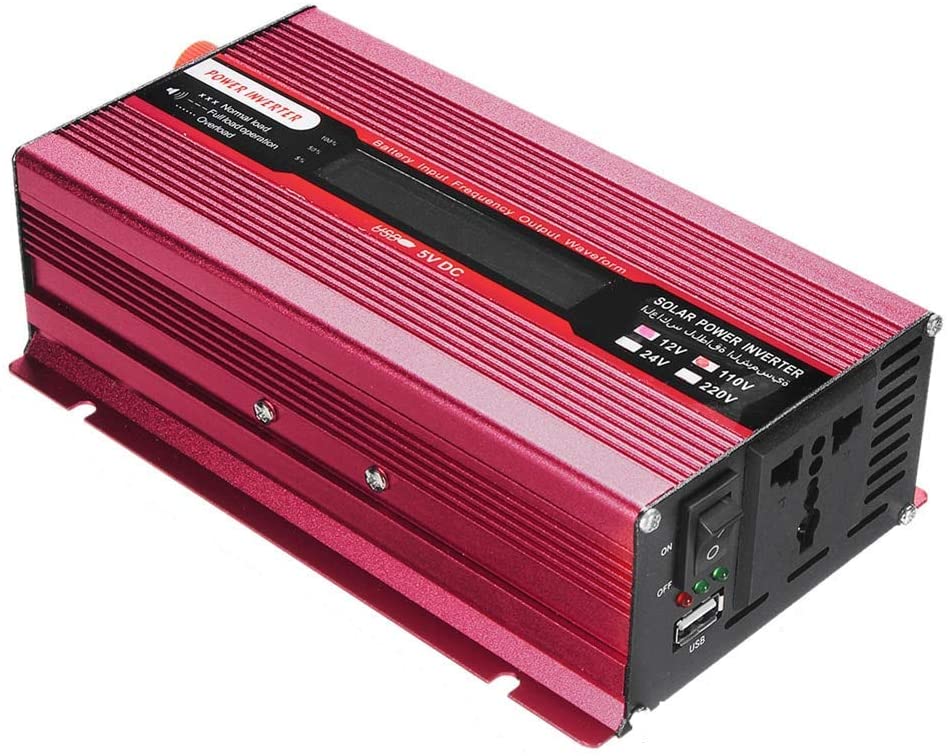
Since he wants to run his 1760-watt well pump, he will need at least a 2,000-watt inverter that can output 220 volts. It’s hard on inverters to run them right at their rated maximum for long periods of time. They get hotter too. There are differences between modified sine wave and full sine wave inverters, but this is not the place to get into those weeds. We will say that an economical 2,000-watt inverter will do. Boom, the last piece figured out.
Pencils Down
There, the sizes of all four components have been calculated based on our design criteria. Now it is time to go shopping.
System Shopping List
Now that we’ve done the math, my neighbor knows what to shop for to assemble a 900 wattHour system: (prices via Amazon searches)
300 watts of solar panels — $75 to $118 each for 100w panels
Two 75 aH deep cycle batteries — $140 to $160 each
One 40-amp charge controller — $16 to $25
One 2000-watt, 220v inverter — $100 to $300
Total system cost (without sundries) — $661 to $999
By way of comparison, Goal Zero’s Yeti 1400 with 300 watts of solar panels would cost around $2,500 and still be a little underpowered for my neighbor’s needs.
As I mentioned above, he could buy these items separately over time. That is how I assembled my solar setup. My little rig cost me $331. I detailed the costs in the battery bank post, so I won’t rehash it here, except to add that buying the bits here and there made it a lot more manageable for me to live within a budget.
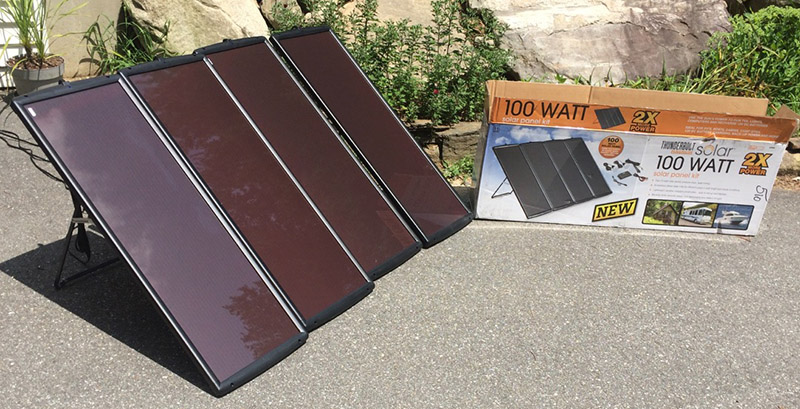
The battery maintainer was discussed in my battery bank post, but basically, it is a little trickle charger (using grid power) to keep your batteries at a healthy full charge when you are not going solar. If left alone, lead-acid batteries will self-discharge over time. Left alone for many months, and they could be too low to be of any use, or worse, so low that they are damaged. A basic little maintainer is cheap insurance.
Cheap Chinese?
Of course, it seems like everything is made in China these days, no matter what US store you buy it from. If you are up for a little risk and adventure, you can shop on AliExpress (dot com) to look for solar panels that are much cheaper than what Amazon sells. In some cases, they are exactly the same product, (made in China) just without the Amazon reseller markup. If you shop carefully (read everything and keep a bit of skepticism), you can save some serious money.
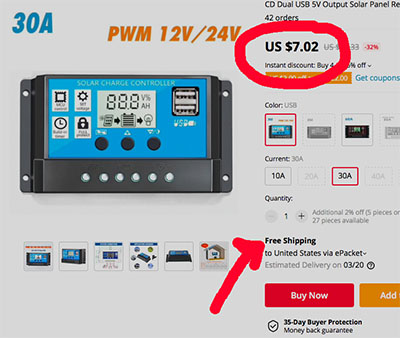
Solar panels can be really cheap from AliExpress. Charge controllers, for example, can be had for the price of a Filet-o-Fish and fries. Lead-acid batteries, however, are not cheaper via AliExpress. Shop around. Know your product.
You can save some bucks via AliExpress. What you WILL give up is instant gratification. To get free shipping, it might take a month for your product to arrive. It’s usually faster than that, but you have to give up thinking Amazon Prime. If you can wait, you can save.
Accepting Plan C Limitations
A budget-friendly backup to your backup generator will not be a magic bullet to shield you from the privations of outages. The truth is, solar and batteries are nowhere near as powerful as the grid or your generator. They can give you long-term peace of mind BUT you won’t be baking a cake while you do laundry while vacuuming, etc.
Solar Stewardship

Knowing that there will be cloudy days, the wise solar farmer will avoid burning wattHours simply because he can. Taking my neighbor for an example again, let’s say his half-hour of pumping can net him 60 gallons of water. (2 gallons per minute for 30 minutes)
If his family uses up all 60 gallons in one day, he will have to pump the next day. What if it is a cloudy day? He might not get any watts to recharge his batteries. Does his family go without water for a day and hope the day after that will be sunny?
As with most resources, it is better to be frugal. Let’s say his family really only needs 10 gallons a day. He could run his pump to fill a 55-gallon drum and not have to pump again for five days. Or, he could run his pump for only 6 minutes to pump 10 gallons. That would use up 180 wattHours. His batteries would have enough charge remaining to do that for five days. This gives him a cushion to get through cloudy spells.
Fuel Stretcher
Another way to use your small-scale solar kit is to extend your generator fuel. You can use your solar and batteries to run small electronics and save your generator fuel for bigger wattage needs. For example, I can charge my laptop, our phones, AA battery chargers, radios, portable tools and some LED lighting with my solar kit. I can save my gasoline for running my fridge or freezer.
By shifting your small use electronics to solar, your generator fuel can last longer. During a crisis, fossil fuel is still likely to be a finite resource, of course. But maybe another week or two is all you’ll need to get to the other side of an extended outage.
Conclusion
I know this was more math but when it comes to solar kits, you need to do the math. By the numbers, many pre-packaged solar kits are really not a very good value for your prepper dollar. Don’t let sales hype fool you. Do the math to see if it’s a good deal for you, or not.
If you go the DIY route, you will need to figure out the proper sizes for the components following the example above. Once you’ve identified the specs of the parts you need, you can get into the weeds over wiring and couplings and brackets, etc.
You can fix yourself up with a Plan C without having the budgetary wind knocked out of you. And, as DIY-ers know, once you’ve tinkered up all the bits, you know your system inside and out. That’s a big help when it comes to use and troubleshooting.
Did you assemble your own solar kit? If so, how did it go?

I dont typically post – but need to point out… if are going to power 220 volt equipment, then you need something that will supply 220 volts. Your example above is to power a 220 volt pump,but appears to use an inverter that will supply 120 volts – which will not power the pump. A 220v appliance will draw from 2 120 volt lines (2 hot lines) – which are 180 degrees out of phase to each other, will have a neutral, and a ground. And 2 inverters would’nt do the trick. Would need a 220 volt inverter.
Might be good to change the example or point this out before someone misunderstands and gets hurt.
Hi Don’t Usually,
Good point. I updated the text to specify that my neighbor would need an inverter that can output 220v. There are quite a few of them out there. I updated the photo to be one of them, just as an example.
Well pumps need a large surge of power to start, probably about 3500 watts in your example, beyond the 2000w capacity given for the inverter. Supplying the power to the capacitor that runs through the starter relay will draw your batteries down in a hurry. To use solar for well pumps, A.C., heat or refrigeration is going to require a large battery bank and a lot more panels.
Hi IvyMike,
Good point about the surge. Most AC motors require an initial higher amperage draw to get started. They then settle down to a running voltage after that. Most inverters seem to have that reality designed in. The one I picked (for my hypothetical) had a surge rating of 4000 watts. After the surge (a fraction of a second), an 8-amp motor draws 8 amps, or 1760 watts.
But, you’re right that such a draw would deplete batteries quickly. That’s why my neighbor would only get a half an hour of pumping time. You’re right that trying to power a house at grid-consumption-levels would take a massive amount of batteries and even bigger solar panels to replenish them. Rather than attempt that, I was suggesting the small-scale solar as a more do-able survival tool.
— Mic
Thanks for the article Mic, I’m officially inspired. This is something I’ve been meaning to start for years but I’m taking action today. Inspiration via Mic!
I love that you laid it out with simple examples. I’m not bad with math but electricity seems impossible for my massive egg (scrambled) to understand. I don’t know a watt from a volt or AD from DC. Although I will admit, one of my favorite bands is, ironically enough, AD/DC. 😉
I’m a hand’s-on type of learner so I know I need to get started to learn anything. I can research and watch a hundred hours of video but won’t understand a thing until I get my hands on it. No time like the present.
Hey Brian,
Glad you’re inspired. Other than some money outlay, it’s not that hard to get started with some small-scale solar. There are some ‘kits’ that run a bit less than HF’s $149 set, but that’s about the range for 100 watts of panel and a charge controller. You’ll need a battery at the very least. It sounds like you’ve got inverters already.
The battery needs to be a “deep cycle” battery — sometimes called a “marine” battery. Regular car batteries are designed for lots of output for a very short time (i.e. the starter) and not for prolonged draining. Car batteries have more and thinner plates so they do that quick output. The thinner plates don’t do well with extended running. Deep cycle batteries have thicker plates that can handle steady use. What they’re not good at is a short burst of big power.
When shopping for batteries, read carefully. Some are labeled as “marine” battery but they’re really just a car battery intended for a boat motor. If they label stats like “Cold cranking amps,” it’s a car battery. Look for Amp-hour ratings instead. Even better if the description warns you that the battery won’t be good for starting your boat engine. But, that means it’s a good battery for a solar battery bank. 🙂
[…] I phrased it like that to avoid talking about solar power, which I’d love to have, but I’m not there yet. ( That, and I’m trying to rank for that particular keyword 😉 ) Here’s one of the better posts out there if you’re interested in setting up solar power. […]